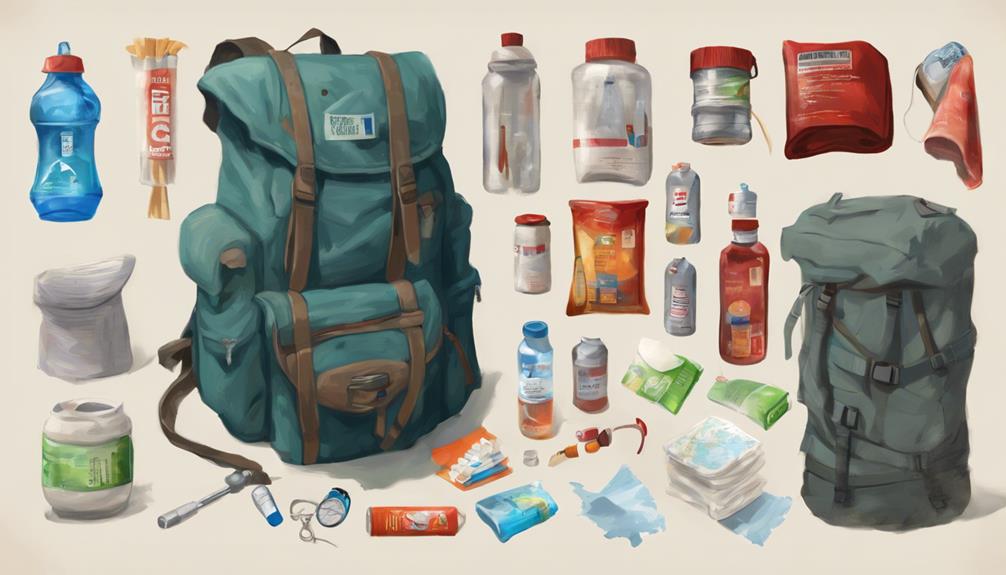When it comes to preparing for unforeseen circumstances, the contents of an emergency kit play a crucial role in ensuring one's safety and well-being. The selection of items to include requires careful consideration and practicality. From sustenance to tools and personal essentials, each component serves a specific purpose in enhancing one's ability to navigate through emergencies effectively. However, the question remains: what other specialized items should be part of an emergency kit to further bolster one's preparedness and resilience?
Key Takeaways
- Pack non-perishable food and water for at least 3 days.
- Include first aid supplies tailored to family needs.
- Safeguard important documents in a waterproof container.
- Prepare communication and lighting devices with backup power sources.
Food and Water
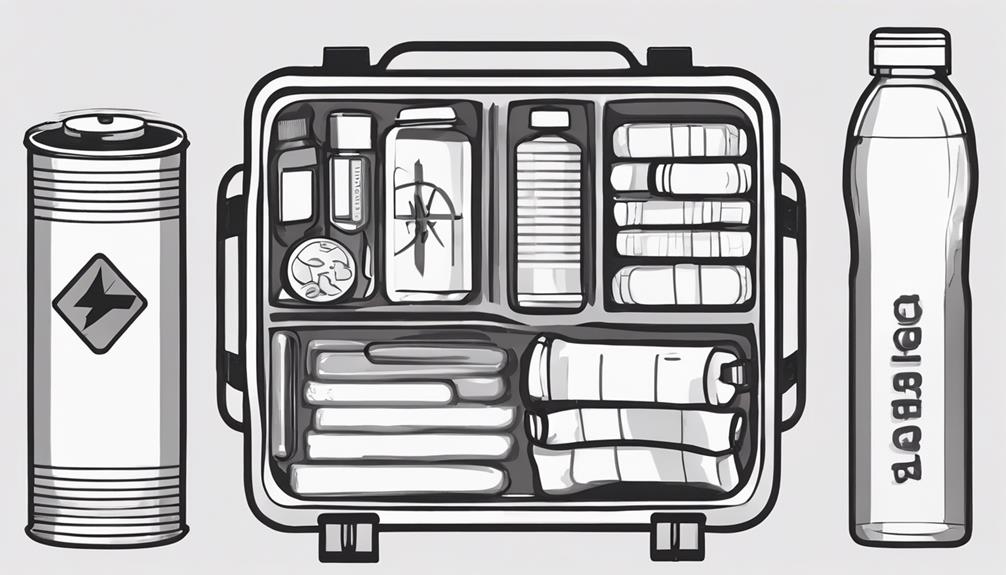
When preparing an emergency kit, the first essential aspect to consider is ensuring an adequate supply of non-perishable food items and water to sustain individuals for at least three days. Canned food is a crucial component of any emergency kit due to its long shelf life and nutritional value. It is recommended to store canned food in a cool, dry place to maintain its freshness and quality for an extended period. Additionally, having a manual can opener in your kit is essential to access the canned food.
Regularly checking expiration dates and rotating food supplies are necessary steps to ensure the items in your emergency kit remain safe for consumption. Moreover, it is vital to consider any dietary restrictions when selecting canned food for your emergency kit to cater to specific needs or allergies. By including a variety of canned food options in your emergency kit, you can ensure that you have a well-rounded and sufficient food supply to sustain you during unforeseen circumstances.
First Aid Supplies
First aid supplies are crucial components of an emergency kit, encompassing items like bandages, antiseptic wipes, and medications for various conditions. Properly stocked with essentials like scissors, thermometers, and pain relievers, these kits can provide immediate care when needed. Understanding the importance of these supplies and how to store them effectively ensures readiness in times of crisis.
Essential First Aid Items
An emergency first aid kit should include essential items such as adhesive bandages, gauze pads, antiseptic wipes, and medical tape. These items are crucial for addressing minor cuts, scrapes, and wounds effectively. Additionally, including scissors, tweezers, a thermometer, and disposable gloves in your kit can aid in providing more advanced care when needed. Having a CPR mask, instant cold packs, a splint, and a first aid manual is essential for handling more serious injuries and medical situations. Supplementary items like pain relievers, allergy medication, and antacids can also prove valuable during emergencies. Regularly checking and replacing expired items in your first aid kit is important to ensure that it is fully equipped and ready for use in times of need.
Importance of Supplies
Given the critical role that first aid supplies play in addressing injuries and health concerns during emergency situations, it is imperative to understand the significance of having a well-equipped kit. Properly stocked first aid supplies can make a substantial difference in providing immediate care and preventing complications. Here are some essential items to include in your emergency kit:
- Bandages, Antiseptic Wipes, and Gauze: These items are crucial for treating cuts and wounds promptly.
- Medications (Pain Relievers, Antihistamines, Antacids): Providing relief from pain, allergies, or digestive issues in emergencies.
- First Aid Manual or Guide: Offers instructions on how to address various health issues effectively.
- Thermometer and Tweezers: Useful for monitoring and handling health concerns during emergencies.
Proper Storage Techniques
Effective storage techniques are essential for maintaining the integrity and accessibility of first aid supplies in emergency kits. Storing first aid items in airtight plastic bags helps protect them from moisture and contamination. Using easy-to-carry containers like plastic bins or a duffel bag ensures convenient access to the supplies when needed. Keeping the first aid items organized and easily accessible allows for a quick response during emergencies. Regularly inspecting and replenishing the first aid supplies is crucial to ensure they are up to date and ready for use. It is also recommended to store prescription medications, bandages, and other essentials in a designated place in your emergency kit for easy retrieval.
| Storage Technique | Benefits |
|---|---|
| Airtight plastic bags | Protects from moisture and contamination |
| Easy-to-carry containers | Convenient access to supplies |
| Organized and easily accessible | Quick response during emergencies |
| Regular inspection and replenishment | Ensures supplies are up to date and ready |
Tools and Supplies
Incorporating a versatile set of tools into your emergency kit is essential for addressing basic repair needs and various unforeseen situations. When preparing your emergency supplies, consider including the following tools and supplies:
- Wrench or Pliers: These tools are crucial for basic repairs that may be needed during emergencies, such as fixing a leak or securing loose parts.
- Multi-Tool or Swiss Army Knife: These tools are versatile and can serve various purposes, from cutting items to opening bottles, making them invaluable in different scenarios.
- Manual Can Opener: Ensuring you have a manual can opener in your kit guarantees that you can access canned food, providing essential sustenance during emergencies.
- Whistle: A whistle can be used to signal for help or alert others to your presence, making it a vital tool for communication in distress situations.
Clothing and Bedding
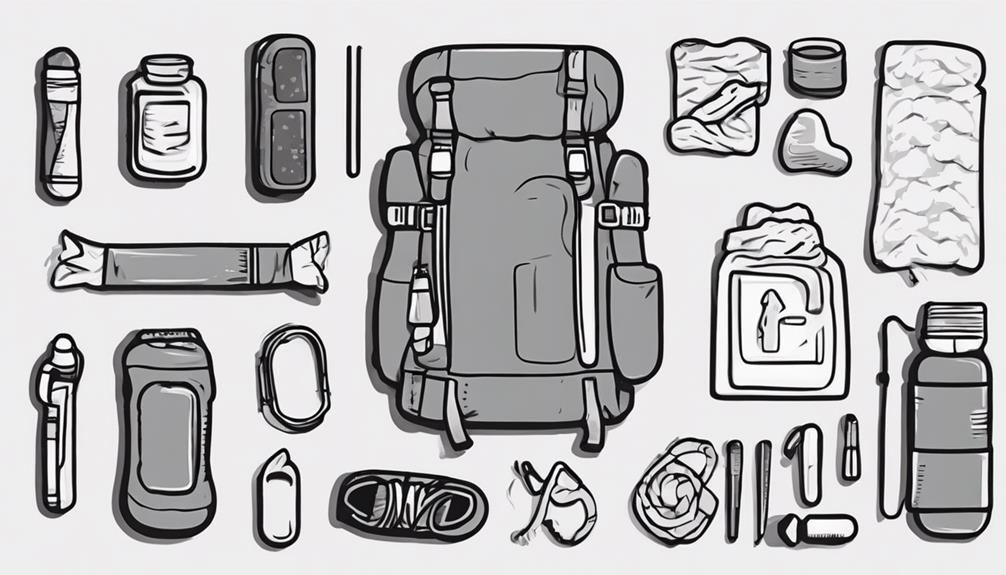
When considering the essentials for an emergency kit, attention to adequate clothing and bedding is paramount for ensuring comfort, safety, and protection in various emergency scenarios. It is crucial to pack a change of clothes and shoes to stay dry and comfortable during emergencies. Additionally, including warm blankets and sleeping bags in the kit can help maintain body heat in cold weather or shelter situations. Weather-appropriate attire such as rain gear and sturdy footwear should also be considered for protection against the elements. Having clean and comfortable clothing readily available can enhance comfort during evacuations. Moreover, addressing specific clothing needs like extra layers for warmth or specialized gear for particular conditions is essential for being prepared. By including a variety of clothing options and bedding items in the emergency kit, individuals can be better equipped to face unexpected situations with confidence and resilience.
Personal Hygiene Items
In emergency preparedness planning, the inclusion of personal hygiene items is crucial for maintaining cleanliness and health in challenging situations. These items not only help prevent the spread of diseases but also contribute to overall well-being amidst disasters. Here are essential personal hygiene items to consider including in your emergency kit:
- Moist Towelettes: These disposable wipes are convenient for cleaning hands, face, and body when access to water is limited.
- Soap and Hand Sanitizer: Proper hand hygiene is vital in preventing the spread of germs. Soap and hand sanitizer help maintain cleanliness when traditional washing facilities are not available.
- Toothbrush and Toothpaste: Oral hygiene is often overlooked in emergencies. Including a toothbrush and toothpaste can help maintain dental health when regular brushing may not be possible.
- Feminine Hygiene Products: Women have specific hygiene needs that must be addressed. Including feminine hygiene products ensures comfort and sanitation for women during challenging times.
Important Documents
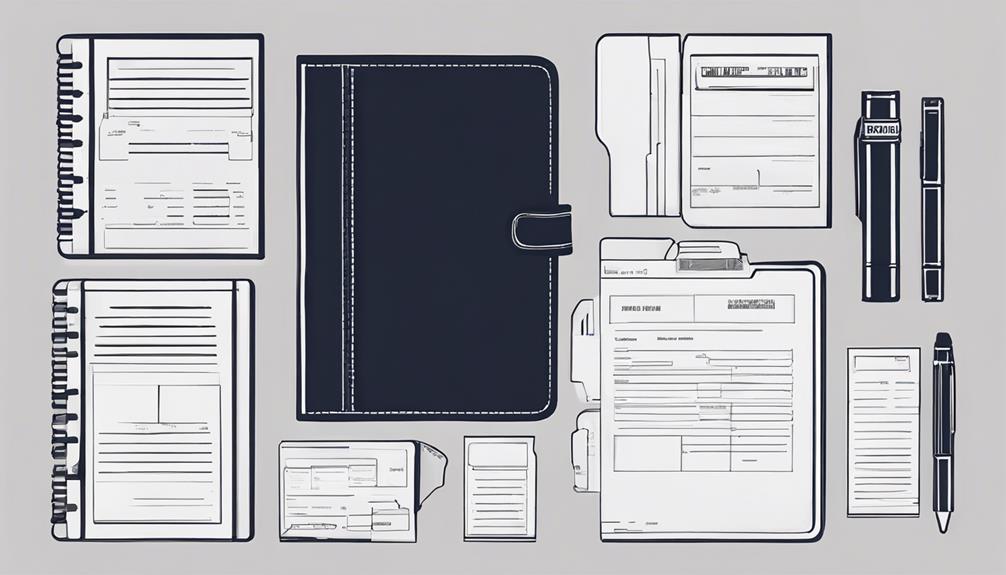
When preparing an emergency kit, it is crucial to include copies of vital documents such as identification, insurance papers, and medical records. These documents should be stored securely to protect them from damage or loss during a crisis. Ensuring easy access and regular updates to these important papers can greatly assist in navigating emergencies effectively.
Vital Record Storage
To ensure preparedness for emergencies, it is essential to securely store vital records, including identification, emergency contact details, and important documents like insurance and medical records in a waterproof container. It is crucial to have quick access to these documents during critical situations. Here are some key points to consider regarding vital record storage:
- Identification: Include copies of IDs for all family members.
- Emergency Contact Information: List contacts for family, friends, and emergency services.
- Insurance Documents: Keep copies of insurance policies for health, home, and auto.
- Medical Records: Include medical history, prescriptions, and vaccination records.
Document Protection Methods
Securing important documents is a critical aspect of emergency preparedness, requiring meticulous consideration of document protection methods to safeguard vital information effectively. Utilizing waterproof document bags or containers can shield important documents in your emergency kit from water damage. Additionally, creating digital copies of essential documents and storing them securely online or on a USB drive provides an extra layer of protection against physical loss or damage. Ensure that identification, insurance policies, medical records, and contact information are included for easy access during emergencies. Place these documents in a secure yet easily accessible location within your emergency kit to facilitate quick retrieval when needed. Regularly updating and reviewing important documents guarantees that they remain current and accurate in case of an emergency.
Communication Devices
Communication devices play a pivotal role in emergency preparedness, enabling individuals to remain connected and informed during critical situations. When assembling an emergency kit, consider including the following basic items to ensure effective communication:
- Battery-Powered or Hand-Crank Radio: These devices can provide crucial updates and alerts during disasters when traditional communication methods may be disrupted.
- Charged Batteries and Backup Power Sources: Ensure that your communication devices have fully charged batteries and consider including portable chargers to maintain functionality during extended emergencies.
- Establish a Communication Strategy: Coordinate with your family or household members to plan how you will stay in touch and share information during emergencies, ensuring everyone's safety and well-being.
- Alternative Communication Tools: In situations with limited cell service, having tools like a whistle can help signal for help or communicate with others in your vicinity, providing an additional layer of security and communication capability.
Lighting and Power Sources
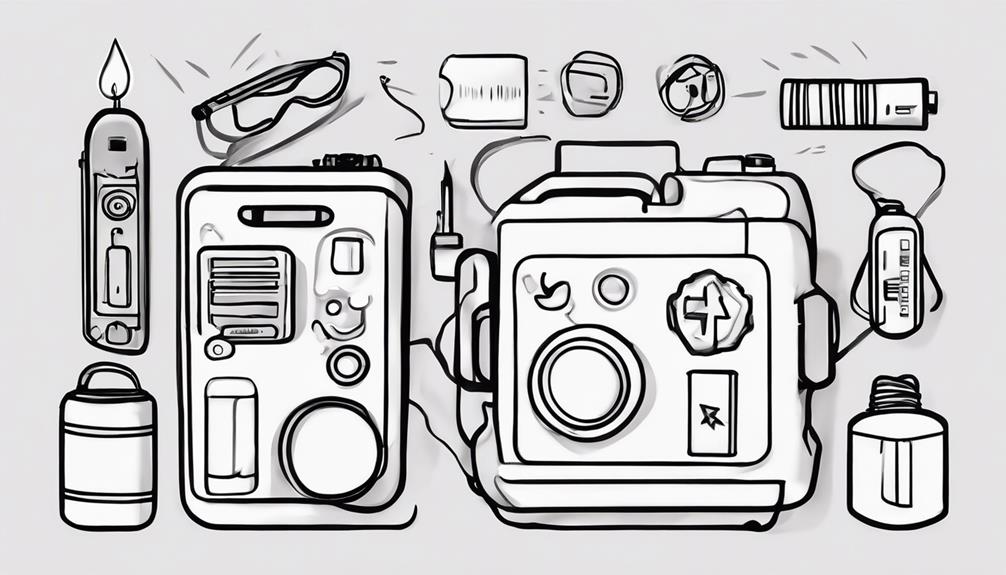
When preparing for emergencies, it is crucial to ensure reliable lighting sources are included in your kit. Flashlights with extra batteries provide essential illumination, while solar-powered options offer sustainable energy solutions. Adequate lighting is essential for safety and visibility during unexpected situations.
Flashlights & Batteries
During emergencies, the inclusion of flashlights and batteries in an emergency kit is crucial for ensuring adequate lighting and power sources. When assembling your emergency kit, consider the following:
- Flashlights: Essential for providing light during power outages or nighttime situations.
- Extra Batteries: Ensure a reliable light source for an extended period.
- LED Flashlights: Recommended for their long battery life and durability.
- Adjustable Brightness: Helps conserve battery power and provides varying levels of illumination.
Regularly checking and replacing batteries in flashlights is vital to ensure they function when needed. By including these items in your emergency kit, you can be better prepared for situations that require reliable lighting and power sources.
Solar Powered Options
Solar powered options for emergency kits offer sustainable and reliable lighting and power sources. These options typically include solar lanterns, flashlights, and power banks, all of which can be charged using sunlight. During emergencies, solar powered lights can provide hours of illumination after a full day of exposure to the sun. Additionally, these devices are environmentally friendly and do not depend on traditional electricity grids, making them well-suited for off-grid scenarios. By incorporating solar powered options into your emergency kit, you ensure access to essential lighting and power even when conventional sources are unavailable. This sustainable approach not only enhances preparedness but also contributes to a more eco-conscious emergency response strategy.
Shelter and Warmth
An essential component of any well-prepared emergency kit is the inclusion of adequate shelter and warmth provisions. When facing unexpected situations, having the right tools to protect yourself from the elements can make a significant difference in your safety and well-being. Here are some key items to consider adding to your emergency kit:
- Tent or Emergency Shelter: Providing a physical barrier between you and the environment, a tent or emergency shelter can offer protection from wind, rain, and cold temperatures.
- Sleeping Bag or Blankets: Insulating yourself from the ground and maintaining body heat is crucial. Packing a sleeping bag or blankets can help you stay warm during emergencies or evacuations.
- Hand Warmers: In cold conditions, hand warmers can provide essential warmth to prevent frostbite and maintain dexterity.
- Ponchos or Emergency Blankets: These lightweight and compact items can help shield you from rain, wind, and snow, offering additional protection when setting up shelter is not an option.
Including these shelter and warmth essentials in your emergency kit can enhance your preparedness and resilience in challenging situations.
Cash and Personal Items
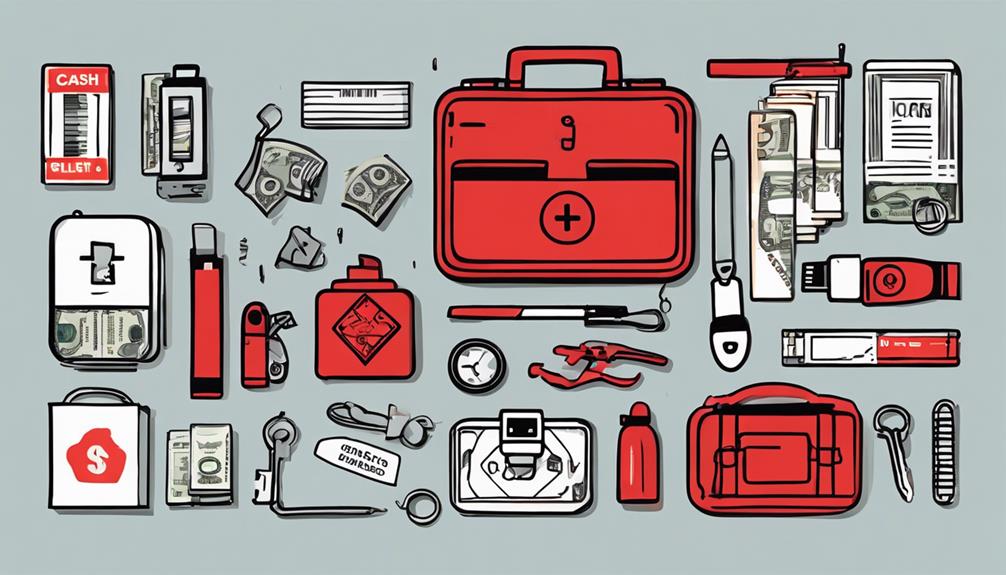
Including cash and personal items in your emergency kit is vital for ensuring preparedness during situations where electronic payment methods may not be accessible. Cash in small denominations can be crucial for purchasing supplies, transportation, or services when ATMs are unavailable. Personal items such as identification, emergency contact information, and important documents should also be included for quick access and reference during emergencies. Having a pen and notepad in your kit can aid in jotting down essential information or messages. Below is a table summarizing the basic items to include in this category:
| Cash and Personal Items | Importance |
|---|---|
| Cash in small denominations | Essential for purchases during emergencies |
| Personal identification and documents | Streamline communication and access to services |
| Emergency contact information | Quick reference for assistance |
| Pen and notepad | Useful for jotting down important information |
Ensuring these basic items are in your emergency kit can significantly improve your readiness and resilience during challenging situations.
Entertainment and Comfort
In times of emergency preparedness, the inclusion of entertainment and comfort items in your kit serves a crucial role in maintaining mental well-being and promoting resilience amidst challenging circumstances. Here are some essential items to consider for your emergency kit:
- Books, Games, Puzzles: Including these items can provide entertainment and comfort, especially for children, helping to alleviate stress and anxiety during emergencies.
- Favorite Toys: Adding a favorite toy for children or comfort items for adults can offer a sense of familiarity and security, contributing to emotional well-being in stressful situations.
- Distraction and Occupation: Entertainment items like games and activities can help distract and occupy individuals, reducing stress levels and fostering a sense of normalcy amidst the chaos of an emergency.
- Mental Well-being: Having entertainment and comfort items in your emergency kit can improve mental well-being, maintain a positive outlook, and enhance overall resilience during challenging times. These items play a significant role in supporting emotional health and coping mechanisms in emergency situations.
Pet and Baby Supplies
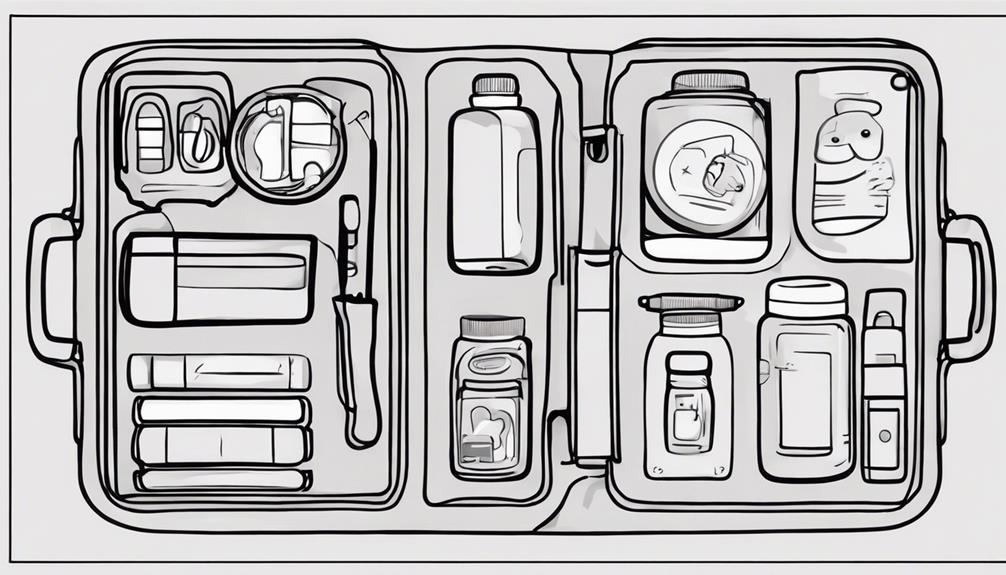
Pet and baby supplies are essential components of an emergency kit, ensuring the well-being and safety of both your furry companions and young children during challenging circumstances. When preparing for emergencies, it is crucial to include baby supplies such as formula and diapers for infants or young children. These items are vital for meeting the basic needs of babies and ensuring their comfort and health during unexpected events. Additionally, packing pet food and supplies for your animals is essential to guarantee their welfare during emergencies. Considering the specific needs of individuals with disabilities or special requirements within your family is also important when assembling an emergency kit. Furthermore, including entertainment items for children can help keep them occupied and calm in stressful situations. It is also advisable to prepare medications and medical supplies for any family members with specific health needs to ensure their well-being is maintained during emergencies. Prioritizing these pet and baby supplies in your emergency kit is crucial for comprehensive preparedness and care for all family members, including the little ones and furry friends.
Frequently Asked Questions
What Do You Really Need in an Emergency Kit?
In an emergency kit, essential items like water, non-perishable food, a flashlight, and a first aid kit are crucial for survival and well-being. These emergency essentials ensure hydration, sustenance, illumination, and medical care during crises. Additionally, personal hygiene items play a vital role in maintaining cleanliness and preventing illnesses. A well-prepared emergency kit should contain these fundamental components to support individuals through challenging situations.
What Are the 7 Supplies That Are Needed for an Emergency Supply Kit?
In an emergency supply kit, essential supplies include emergency food rations, water, a flashlight with spare batteries, a first aid kit, personal hygiene items, a multi-tool, and a portable phone charger. Emergency food provides sustenance during crises, while water ensures hydration. A flashlight aids visibility in low-light conditions, while a first aid kit addresses medical needs. Personal hygiene items maintain cleanliness, a multi-tool offers versatility, and a phone charger keeps communication devices powered.
What Are the 5 Items That You Should Include in Your Emergency Kit?
In an emergency kit, it is crucial to include essential items for sustenance and safety. Prioritize emergency food with a minimum of a 3-day supply of non-perishable items. Additionally, ensure access to clean water, a reliable light source like a flashlight, a well-equipped first aid kit for medical needs, and personal hygiene items for sanitation. These components are critical for ensuring preparedness and resilience during unforeseen crises.
What Should a Girl Have in Her Emergency Kit?
In an emergency kit, a girl should consider including essential items like personal hygiene products, medications, and comfort items. Additionally, emergency makeup can be a valuable addition for maintaining a sense of normalcy during uncertain times. By ensuring the kit contains these items tailored to her specific needs, a girl can be better prepared to navigate challenging situations with a sense of comfort and practicality.
Conclusion
In conclusion, the items included in an emergency kit are crucial for ensuring survival and safety during unforeseen circumstances. It is imperative to have a well-rounded selection of supplies such as food, water, first aid supplies, tools, clothing, personal hygiene items, shelter, cash, and entertainment for comfort. By being prepared with a comprehensive emergency kit, individuals can mitigate risks and enhance their ability to cope with emergencies effectively.
